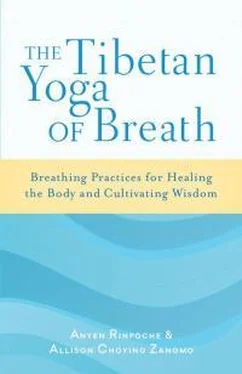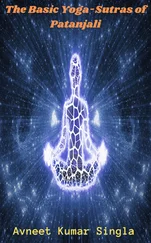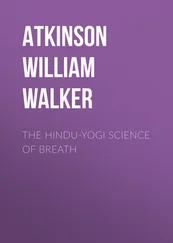Exercise 1

LEARN HOW YOU BREATHE
To experience these two styles of breathing, try this exercise: Place one hand on your belly and the other hand on your heart. Now take a deep breath. Did you feel your rib cage elevate and expand? That is thoracic breathing (exaggerated, of course, by the deep inhalation). Now take in a deep breath but concentrate on not moving your rib cage. Instead, slightly push your stomach out into your hand. Try to breathe so that the hand placed over your heart does not move. This is abdominal breathing. Repeat this a few times, exploring the subtleties of the muscle groups working, until you can feel the difference.
THE SCIENCE OF THE BREATH
When we are physically and mentally healthy, these two styles of breathing work together. When the body’s metabolic demands require an immediate short-term energy boost, thoracic breathing supports this increase. Thoracic breathing is not necessarily unhealthy; it is just less efficient. When we are at rest, abdominal breathing is more efficient than thoracic breathing. It is slower, deeper, and more calming to the body and mind, which intuitively leads to the feeling that abdominal breathing must have positive, cumulative health effects.
Just as abdominal breathing can have a long-term beneficial effect on the body, the absence of abdominal breathing may indicate an absence of health or the presence of a medical condition. Indeed, medical research shows that people who are ill take more thoracic breaths even when at rest than people who are healthy. 4Some medical conditions, such as heart disease, asthma, cancer, and cystic fibrosis, are associated with higher breathing rates—patients breathing in two to three times more air in a minute than healthy people. 5Excessive thoracic breathing is not uncommon; in fact, surveys suggest that 60 percent of ambulance runs in major US cities were to provide medical care for persons suffering from symptoms directly related to “overbreathing,” 6also called hyperventilation .
Oxygen in the blood. What are the effects of thoracic breathing when we are at rest—in other words, breathing in excess of the metabolic demands of the body? When we overuse the accessory breathing muscles—the muscles in the shoulder girdle as well as the chest wall—as we do when we engage in thoracic breathing, the upper lungs quickly fill with air. However, oxygen exchange is less efficient in the upper lungs. The lower lungs are six to seven times more efficient at exchanging oxygen for carbon dioxide, due to gravity, which pulls the blood supply into the lower lungs, giving more time for oxygen and carbon dioxide to exchange. Thus, breathing with the upper lungs provides the body with less oxygen than breathing with the lower lungs. 7
Carbon dioxide in the blood. However, less oxygen in the blood is not the only issue; less carbon dioxide in the blood is also problematic. Carbon dioxide is necessary for oxygen to be released within the bloodstream, and it is also an important vasodilator; it opens the blood vessels so that blood can flow through. Additionally, a lack of carbon dioxide causes the smooth muscle in the digestive tract and connective tissue to contract, which restricts blood flow. 8When the blood vessels constrict, the blood is unable to carry the necessary amount of oxygen to the organs and brain, and the heart also has to work harder to circulate blood throughout the body. When we breathe too shallowly and too rapidly, such as when we breathe thoracically at rest, carbon dioxide is exhaled faster than it is produced, and carbon dioxide levels in the blood decrease. Even though it seems like we are getting more oxygen into our bodies when we breathe rapidly, we are not. Breathing thoracically at rest decreases carbon dioxide levels in the blood, which in turn deprives the tissues of the body, including the organs and the brain, of oxygen. 9
pH balance in the body . And there is more scientific evidence that links the effects of breathing to our health and wellness. Too little carbon dioxide in the blood results in a higher blood pH, increasing blood pH from 7.4 to 7.5. 10This can lead to a medical condition called respiratory alkalosis . Respiratory alkalosis may sound like a complicated disorder, but we can understand it by relating it to what we know about systems in balance. When a system, such as groundwater, becomes either too basic (alkaline) or too acidic such that its pH is not in equilibrium, it becomes unhealthy, and its ability to sustain life becomes compromised. The same is true of the blood. If blood pH is out of balance, in this case too alkaline, that imbalance spreads throughout the body. The blood’s ability to sustain our body’s overall health becomes compromised. Respiratory alkalosis is associated with many chronic health conditions, and can be an early or intermediate indicator of cardiac and pulmonary disorders, diseases that affect the heart and lungs.
Cell function . Additionally, the cells in our bodies behave differently depending on how much oxygen is available to them. Some doctors and medical researchers believe that reduced cell oxygenation is the driving force behind many chronic diseases. Cell hypoxia is a disorder in which cells are deprived of oxygen, and some research shows that cell hypoxia encourages the growth of cancerous tumors. 11Also, when the cells in the heart-muscle tissues are deprived of oxygen, this results in heart problems and a painful heart condition called angina agony . Other diseases, such as diabetes, 12cystic fibrosis, 13asthma, 14bronchitis, 15osteoporosis, 16and gastrointestinal disorders, 17are all associated with low amounts of oxygen in the brain or other bodily organs.
Deep abdominal breathing promotes full exchange of oxygen for carbon dioxide. An important point to be aware of is that the word deep refers to the depth of breath in the lungs. Research shows that this type of breathing can slow the heartbeat and lower or stabilize blood pressure. 18A lower resting heart rate and low blood pressure are general signs of good health.
THE BREATH, WIND ENERGY, AND WELL-BEING
The breath is not only a source of support for the physical body; it is also a support for mental, emotional, and spiritual well-being. The mental, emotional, and spiritual aspects of the breath are easily understood in the context of traditional Tibetan language and philosophy, where the air element is central to all of life—including all of our physical, mental, and spiritual experiences.
In the Tibetan Buddhist teachings, the element of air and the breath are tied together through the word lung (Tib. rlung), which is embedded with several layers of meaning. Lung describes not only the breath, the movement of air we call wind, and the basic atmosphere around us, but it has the additional meaning of “wind energy.” From the point of view of Tibetan medicine, physiology, and the practice of meditation, the physical body is permeated by five types of wind energy, which support the body’s most basic functions, such as circulation, digestion, and excretion. Therefore, according to Tibetan medicine, the breath is part of an intricate system of wind energy that regulates and supports the body’s health. For this reason, we often use the words breath and wind energy interchangeably. However, while the breath is one form of wind energy, referring to wind energy speaks to our entire bodily system, and all of its physical, mental, and emotional components. Tibetan medicine tells us that when all the wind energy is in balance, all of the body’s basic systems work efficiently and we feel healthy.
Although there are some differences in the style of explanation, the results of imbalanced wind energy are very similar to the explanations given by Western medical science. From the point of view of Tibetan medicine and physiology, when wind energy becomes too excessive and builds up in the upper part of the lungs, as occurs during thoracic breathing, this can result in a condition called nying lung (Tib. snying rlung), literally “heart-wind.” When we experience nying lung, the wind energy in the region around the heart and lungs has become too strong and too agitated.
Читать дальше













